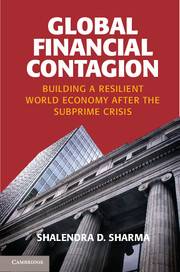Book contents
- Frontmatter
- Contents
- List of Figures
- List of Tables
- Acknowledgments
- Introduction
- One The United States
- Two The Bush and Obama Administrations’ Response
- Three From the U.S. to the European Crisis
- Four The Eurozone’s Sovereign-Debt Crisis
- Five Russia
- Six China
- Seven Japan, South Korea, and India
- Eight The Middle East amid the Global Financial Crisis
- Nine The Great Recession and the World’s Poorest
- Ten G-20 World
- Bibliography
- Index
Introduction
The Great Recession of 2007–2009
Published online by Cambridge University Press: 05 June 2014
- Frontmatter
- Contents
- List of Figures
- List of Tables
- Acknowledgments
- Introduction
- One The United States
- Two The Bush and Obama Administrations’ Response
- Three From the U.S. to the European Crisis
- Four The Eurozone’s Sovereign-Debt Crisis
- Five Russia
- Six China
- Seven Japan, South Korea, and India
- Eight The Middle East amid the Global Financial Crisis
- Nine The Great Recession and the World’s Poorest
- Ten G-20 World
- Bibliography
- Index
Summary
The months of August–September 2008 will forever be remembered as the time when the economic tsunami hit Wall Street. On September 7 the venerable “models” of mortgage finance (the government-sponsored enterprises Fannie Mae and Freddie Mac), which together had more than $5 trillion in mortgage-backed securities and debt outstanding, collapsed. The authorities placed both into conservatorship in the hopes of stabilizing the housing and mortgage-finance markets. This clearly did not happen. On September 15, the world witnessed the fire sale of the investment bank and stock-market “bull” Merrill Lynch to Bank of America and, more ominously, the bankruptcy of the 154-year-old investment bank, Lehman Brothers, the largest company ever to fail in the United States. The collapse of Lehman (which had more than $600 billion in assets and some 25,000 employees), proved to be a fork in the road – an inauspicious event – that transformed the subprime crisis into a catastrophic global financial crisis and ushered in the “Great Recession.”
As Lehman was a counterparty in many financial transactions across several key markets, its failure predictably triggered defaults on contracts all over the world. Lehman’s collapse rapidly reverberated throughout the financial system, destroying confidence in money market funds, which in turn, exacerbated problems in the commercial-paper market. Deeply concerned that a massive run on the money markets could destroy the commercial-paper market and thereby bring the entire economy to its knees, the Federal Reserve Board intervened by providing liquidity to money market investors and insured all money market deposits (Allen and Moessner 2011; Mehrling 2011; Wessel 2009). Yet the collateral damage continued unabated. The very next day (September 16), it became public that the nation’s largest insurer, American International Group (AIG), could no longer honor the credit-default swaps (CDS) it had sold to banks. Fearful that AIG’s collapse would have a domino effect and bring down banks and investment firms, the Federal Reserve Board gave AIG an emergency credit line totaling $85 billion to facilitate an “orderly” downsizing of the company.
- Type
- Chapter
- Information
- Global Financial ContagionBuilding a Resilient World Economy after the Subprime Crisis, pp. 1 - 31Publisher: Cambridge University PressPrint publication year: 2013



